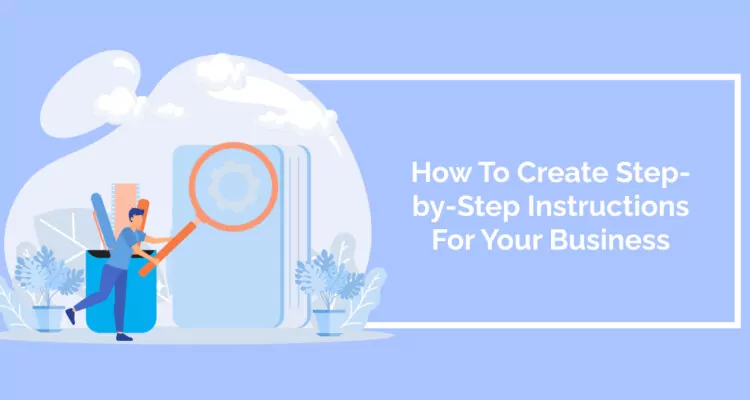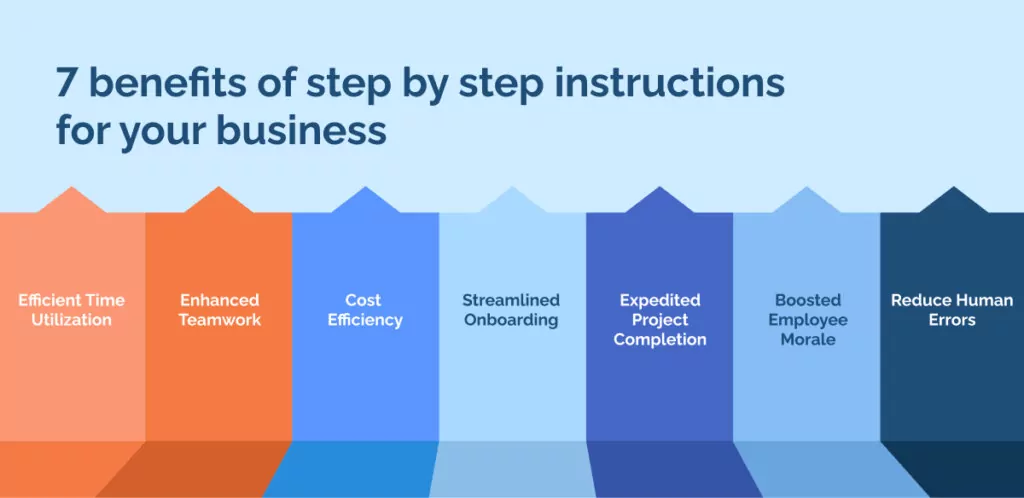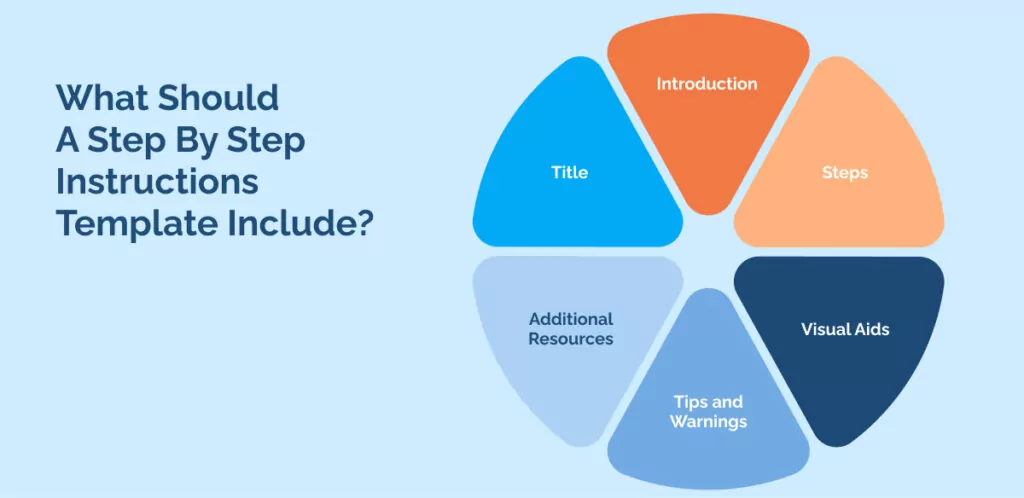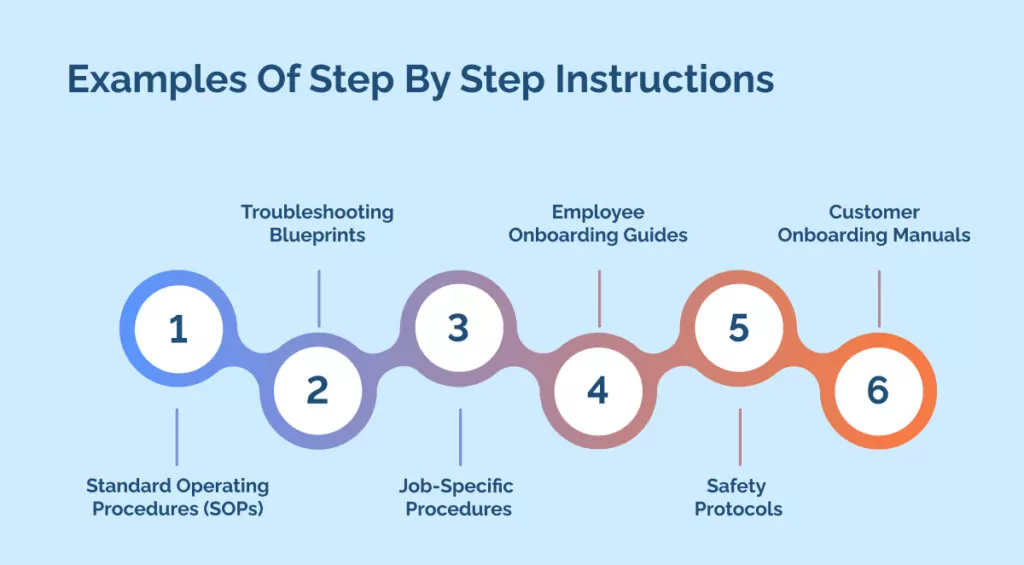
Step-by-step instructions provide comprehensive guidance for workers or final users on task execution, enhancing understanding of a procedure’s intricacies and enabling team members to consistently work together and replicate success.
These structured guides educate new staff members, offer supplementary training, and assist in knowledge management.
Step-by-step instructions can be formulated for virtually any process.
Whether initiating project documentation, scripting customer service calls, navigating a new TV’s functions, onboarding new staff, or making online purchases, such guides aid readers in achieving their goals.
Such detailed instructions often serve as the most straightforward route to guide someone through a task, especially if it’s intricate or has multiple stages.
Utilizing step-by-step guides, teams can work synergistically and attain consistent success. They’re invaluable for training newcomers, reinforcing existing training, and facilitating the documentation and dissemination of expertise within a company.
By the end of this article, you will know:
- What step-by-step instructions are, and why they are vital for your business
- What a step-by-step instructions template should include
- Examples of ways that organizations can use step-by-step instructions
- The steps you need to take to create effective step-by-step instructions
What Are Step By Step Instructions
Step-by-step instructions provide a comprehensive breakdown of a procedure, divided into individual tasks. These instructions can be used for various purposes, from crafting a website to preparing a dish.
Such guides can be categorized as internal or external. Internal guides define specific methods to execute tasks or activities, commonly called standard operating procedures (SOPs). They help in passing on knowledge among staff members.
External instructions can also target the organization’s potential clients or existing customers. These guides present walkthroughs and recommended practices to help users fully leverage a product, service, or tool.
The process’s intricacy can dictate the content of step-by-step guides or instructions. To enhance understanding, these guides might incorporate screenshots, videos, gifs, sample scenarios, and other illustrative components.
Why Are Step By Step Instructions Important For Your Organization?
Step-by-step instructions are pivotal to efficient business functioning, serving as a blueprint to streamline internal processes by highlighting the essential steps employees should take to achieve a set goal.

Here are some compelling reasons to create step-by-step manuals for your teams:
- Efficient Time Utilization: Accessible how-to guides can help employees with simpler tasks to focus on more productive endeavors.
- Enhanced Teamwork: Digital documentation can be a primary tool for bolstering employee collaboration.
- Cost Efficiency: Documenting processes can ensure that all employees have the same knowledge to complete tasks.
- Streamlined Onboarding: Comprehensive step-by-step manuals conserve managerial time and equip new recruits with the essential information to excel in their roles.
- Expedited Project Completion: Employees often waste time replicating existing expertise or deferring tasks when knowledge isn’t shared. This can lead to project lags, which can be sidestepped with standardized processes.
- Boosted Employee Morale: Employees become unhappy when they can’t procure information vital to their tasks. Having readily available guidelines empowers employees, fostering proactive workplace behavior.
- Reduce Human Errors: By formulating and disseminating instructional guides that encapsulate key operational steps, businesses can stop mistakes attributed to procedural oversight.
What Should A Step By Step Instructions Template Include?

Having a uniform template for step-by-step instructions can greatly enhance comprehension and implementation.
Adopting a consistent structure when detailing processes allows employees to navigate them effortlessly, giving them confidence that they’re not overlooking any crucial information.
If you’re considering designing your instruction template, here’s a recommended structure to get started:
Title
Purpose: Grabs the reader’s attention and provides a quick overview.
Tips: Aim for clarity and brevity. Steer clear of ambiguous or convoluted titles that might deter or baffle the reader.
Introduction
Purpose: Sets the stage, providing context and clarifying the objective.
Tips: Concisely convey the significance, any prerequisites, or essential data the reader should be aware of before diving into the steps.
Steps
Purpose: Serves as the core of the instructions.
Tips: Decompose the procedure into lucid, singular-action steps. Adopt bullet points or numbered lists for clarity. Ensure a logical sequence so readers can smoothly transition from one step to the next without hitches.
Visual Aids
Purpose: Augment understanding by offering visual demonstrations.
Tips: Incorporate relevant images, diagrams, or screenshots. GIFs and videos can be particularly helpful for intricate or challenging steps to elucidate with words alone.
Tips and Warnings
Purpose: Equips readers with additional guidance and alerts them to potential pitfalls.
Tips: Highlight safety precautions, best practices, or shortcuts. Make sure these tidbits genuinely enhance the primary instructions.
Additional Resources
Purpose: Points readers towards supplementary information or help.
Tips: Reference relevant articles, video tutorials, or forums. Ensure these resources align with your instructions and provide added value.
Examples Of Step By Step Instructions

Step-by-step instructions are pivotal for presenting intricate procedures and introducing fresh processes in virtually any organization.
Let’s delve into the various examples of step-by-step instructions:
Standard Operating Procedures (SOPs)
Standard operating procedures refer to routine actions that necessitate consistent execution. These span functions like manufacturing, logistics, and even administrative tasks like form-filling or machinery operation.
With intricate procedures demanding exact sequential steps, the presence of structured guides can lead to consistency. By documenting SOPs, you can instill confidence in your workforce, ensuring uniformity and accuracy in execution.
Troubleshooting Blueprints
Crafting well-defined troubleshooting manuals equips employees to swiftly and adeptly address minor technical snags. Such guides typically encompass problem identification, diagnostic measures, and solution implementation.
With these in place, organizations can diminish reliance on tech teams, curtail operational hiccups, and safeguard the workflow from tech disruptions.
Job-Specific Procedures
A step-by-step process tailored for particular job roles can be immensely beneficial. For instance, sales teams might find employee training guides on client communication useful, while marketing mavens could benefit from SEO guidelines.
This proactive approach ensures employees remain focused on their tasks, eliminating guesswork.
Employee Onboarding Guides
One prime area where step-by-step instructions shine is during the new employee onboarding phase. Human Resources professionals and team leaders often curate comprehensive guides to ease new employees into the organizational fold.
Such guides serve as a potent alternative to face-to-face sessions and direct mentoring. This streamlines the onboarding process and ensures existing employees can continue their undisturbed tasks.
Safety Protocols
Safety can’t be compromised. Step-by-step instructions detail safety norms, whether for hazardous material handling, machinery operation, emergency responses, safety audits, PPE usage, or specialized tasks like working at heights, are indispensable.
Such comprehensive guides act as a protective shield, forewarning employees of potential hazards and offering preventive strategies.
Customer Onboarding Manuals
Guides aren’t just for internal use. Crafting concise instructions for customers for account set-up, product familiarization, or acquainting them with updates can enhance user experience.
These step-by-step user manuals become the bridge, especially when products undergo changes or feature additions, navigating users smoothly through new terrains.
Creating Effective Step By Step Instructions

Now that you’re acquainted with the diverse applications of step-by-step instructions and their advantages, let’s delve into crafting them.
Crafting step-by-step guides might seem intuitive, but adhering to certain best practices can amplify their effectiveness for your team and users.
Without any further ado, here’s a guide to devising step-by-step instructions:
Pinpoint the Issue(s)
Before diving into process documentation, ensure you’re not replicating existing steps. It’s crucial first to decide which processes merit documentation.
Engage with both team members and leaders to understand their routine tasks. Initiate with broad categories (like ‘sales strategies‘) and then drill down to specifics (like ‘LinkedIn sales outreach‘). Broad subjects will create classes, while specific processes will reside as individual guides within these categories.
For customer-centric guides, delve into customer feedback, recurrent challenges, and frequent queries. Evaluating customer interactions and support records can offer invaluable insights.
Understand Your Audience
Determine the primary end users of your guide. Is it tailored for new hires or designed to assist seasoned employees? Will it cater to a particular department or serve the entire organization?
Your answers will clarify if there’s a need to elaborate on jargon, familiarize readers with tools, or set the context. Recognizing your target audience in advance ensures that your guide is neither simplistic nor unnecessarily complex.
Specify the Task or Process
Begin by providing a clear title for the task or process your instructions are detailing.
A straightforward label ensures employees can effortlessly locate and refer to it initially and for any subsequent references when they need a refresher on the standard procedure.
Appoint Responsible Parties
For time-bound projects, it’s crucial to designate specific roles to individual team members, ensuring clarity on mutual responsibilities. Always mention relevant contacts for more enduring tasks, such as requesting vacation days.
However, frequently update the guide to prevent users from contacting outdated contacts.
Choose Your Preferred Instructions Format
Your choice of format will hinge on your intended audience, the specific process you’re illustrating, and the resources at your disposal.
Delve into the different instructional mediums you can utilize:
Text-Based Instructions
Description: These are sequenced written guidelines, often complemented by visuals like annotated screenshots, diagrams, or images. They can be manifested as online help pages, PDF files, or traditional paper manuals.
Pros: Excellent for detailing technical steps, easily updated, and distributable in digital and physical formats.
Cons: Might not cater to visually inclined individuals or those with reading challenges.
Video Tutorials
Description: Visual demonstrations of a procedure, perfect for showcasing tangible tasks such as equipment operation or software walkthroughs.
Pros: Cater to visual and auditory learners, provide a dynamic experience, and can be easily shared online.
Cons: They require more resources and time to produce and might pose accessibility issues for individuals with visual or auditory impairments.
Interactive Simulations
Description: Digital simulations that offer an immersive, hands-on approach to learning. Ideal for tasks that demand practical engagement, like medical procedures or machine operations.
Pros: Highly interactive, ideal for tactile learners, and provides instantaneous feedback.
Cons: Resource-intensive in creation, and some might lack the requisite technology or software to engage.
Online Courses
Description: A holistic instructional method combining text, visuals, videos, and quizzes.
Pros: Visually appealing and versatile, catering to a spectrum of learning styles – auditory, visual, or tactile.
Cons: It may require more time and resources to design effectively.
Settle on a Suitable Software
After laying the groundwork, pinpoint the software that aligns with your tutorial’s objectives. The nature of your guide might sway you towards diverse tools, from straightforward ones like Google Docs to intricate video editing software.
Here are the factors to consider:
- Features: Ascertain that the software equips you with essential functionalities such as video editing, screen capturing, infographic creation, or assessment features.
- User-friendliness: Seek platforms with a clear, easy-to-navigate interface that doesn’t necessitate an extensive learning curve.
- Collaborative Capabilities: Ensure the software supports collaborative work, permitting multiple contributors to the same project and facilitating smooth sharing and feedback processes.
Detail the Steps Involved
Start by charting out the optimal steps to achieve the task or process. This might require feedback from staff more familiar with specific procedures. Engage with team leads to ascertain which details are imperative and which can be excluded.
Flesh Out The Steps Thoroughly
It’s time to elaborate on each step, providing comprehensive instructions. This stage is perfect for integrating visuals like charts, diagrams, videos, or screenshots. Determine the balance between when a screenshot might suffice or a GIF would be apt.
Provide Guidelines for Deviations
While laying out the precise steps, guiding employees on deviations is equally crucial. Delineate instances when they might need to stray from the guide and provide directions for such situations.
Even if the next step is consulting a superior, it saves employees from second-guessing.
Pilot the Documented Process
With your instructions set, it’s trial time! Implement the steps with those who’ll be responsible for the same task. Monitor the process’s efficiency and gather feedback. Being open to critiques aids in recognizing areas of enhancement.
Circulate Amongst Your Team
The efficacy of your guide hinges on its dissemination.
Ensure widespread adoption by:
- Broadcasting new manuals via company communication tools, such as email or Slack.
- Integrating the guide library links into your collaboration platforms.
- Spotlighting fresh guides and updates within your internal knowledge repository.
- Deploying bots that track modifications in the repository and relay updates via selected communication channels.
- Encouraging collaborative feedback on your manuals.
Periodic Revisions
Your responsibility doesn’t end once a guide is created. To retain its relevance, regular updates are essential.
Set aside time, monthly or quarterly, to review and refine your guides in line with evolving processes.
Thoughts On The Future Of Step By Step Instructions
The future of step-by-step instructions is evolving rapidly with the advent of technology.
We are moving away from traditional paper-based manuals towards digital-first interactive guides. These innovative technologies offer real-time, context-specific instructions that can be easily updated and customized.
Artificial Intelligence (AI) is predicted to play a significant role in this evolution. AI can use machine learning (ML) to analyze user behavior and provide personalized instructions based on individual needs. This will lead to more efficient understanding and task execution, as the instructions will be tailored to each user’s skills and knowledge level.
The future of step-by-step instructions will likely involve greater integration with other systems. For example, instructions could be linked with performance management tools to monitor progress and provide feedback.
The future of step-by-step instructions is set to become more dynamic, personalized, and integrated, driven by technological advancements, enhancing learning and productivity and potentially transforming various industries.
WalkMe Team
WalkMe spearheaded the Digital Adoption Platform (DAP) for associations to use the maximum capacity of their advanced resources. Utilizing man-made consciousness, AI, and context-oriented direction, WalkMe adds a powerful UI layer to raise the computerized proficiency, everything being equal.



